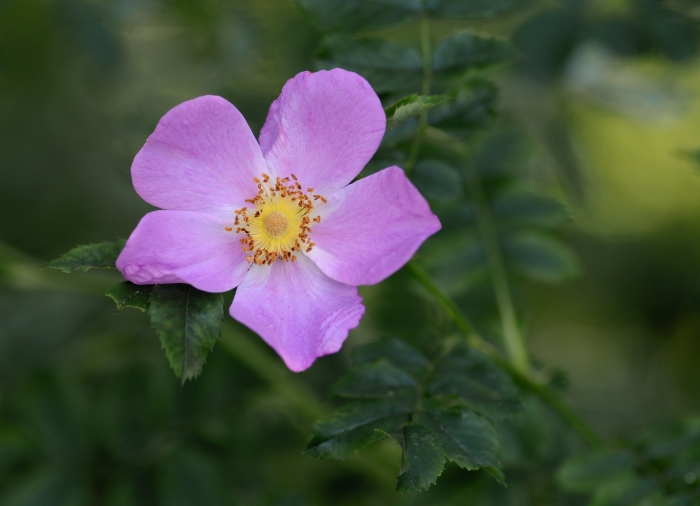Virginia Rose
(Rosa virginiana)
Virginia Rose (Rosa virginiana)
/
/

Alvesgaspar
CC BY-SA 3.0
Image By:
Alvesgaspar
Recorded By:
Copyright:
CC BY-SA 3.0
Copyright Notice:
Photo by: Alvesgaspar | License Type: CC BY-SA 3.0 | License URL: https://creativecommons.org/licenses/by-sa/3.0 | Uploader: Alvesgaspar | Publisher: Wikimedia Commons | Title: Rosa_Helsinki_July_2013-2.jpg | Notes: {{Information |Description={{en|1=Royal Palm Trunk}} |Source={{own}} |Author=[[User:Kumar83|Kumar83]] |Date=2009-09-26 |Permission= |other_versions= }} |



























Estimated Native Range
Summary
Rosa virginiana, commonly known as the Virginia Rose, is a deciduous shrub native to open woodlands, forest edges, and coastal areas of the Northeastern USA and Southeastern Canada. This species is well-adapted to a variety of habitats, including dunes and rocky shores, where it contributes to soil stabilization and habitat complexity. It typically grows up to 2 meters in height, forming a dense thicket with stems covered in numerous hooked prickles. The foliage is pinnate with 5 to 9 leaflets and turns yellow to red in the fall. The pink flowers, which are 5-8 cm in diameter, bloom from June to July, are borne singly or in small clusters, and are highly attractive to pollinators. The fruits, or hips, are small, round, bright red, and persist into winter, providing food for wildlife.
The Virginia Rose is valued for its hardiness, low maintenance, and ecological benefits, such as attracting birds, bees, butterflies, and hummingbirds. It has earned the Royal Horticultural Society’s Award of Garden Merit, indicating its exceptional qualities for garden use. Commonly used in naturalistic plantings, as a border shrub, or for erosion control, it thrives in full sun to partial shade and prefers well-drained soils but is adaptable to various conditions. While it requires medium amounts of water, it is drought-tolerant once established. Gardeners should be aware that it can spread by suckers, potentially becoming invasive in some settings. Pruning after flowering can help maintain its shape and control spread.CC BY-SA 4.0
The Virginia Rose is valued for its hardiness, low maintenance, and ecological benefits, such as attracting birds, bees, butterflies, and hummingbirds. It has earned the Royal Horticultural Society’s Award of Garden Merit, indicating its exceptional qualities for garden use. Commonly used in naturalistic plantings, as a border shrub, or for erosion control, it thrives in full sun to partial shade and prefers well-drained soils but is adaptable to various conditions. While it requires medium amounts of water, it is drought-tolerant once established. Gardeners should be aware that it can spread by suckers, potentially becoming invasive in some settings. Pruning after flowering can help maintain its shape and control spread.CC BY-SA 4.0
Plant Description
- Plant Type: Shrub
- Height: 4-6 feet
- Width: 6-8 feet
- Growth Rate: Moderate
- Flower Color: Pink
- Flowering Season: Spring, Summer
- Leaf Retention: Deciduous
Growth Requirements
- Sun: Full Sun, Part Shade
- Water: Medium
- Drainage: Fast, Medium
Common Uses
Bee Garden, Bird Garden, Butterfly Garden, Edible*Disclaimer: Easyscape's listed plant edibility is for informational use. Always verify the safety and proper identification of any plant before consumption., Erosion Control, Fire Resistant, Fragrant, Hedges, Salt Tolerant, Showy Flowers, Street Planting
Natural Habitat
Native to open woodlands, forest edges, coastal areas, dunes, and rocky shores
Other Names
Common Names: Common Wild Rose , Prairie Rose
Scientific Names: Rosa virginiana
GBIF Accepted Name: Rosa virginiana Herrm.